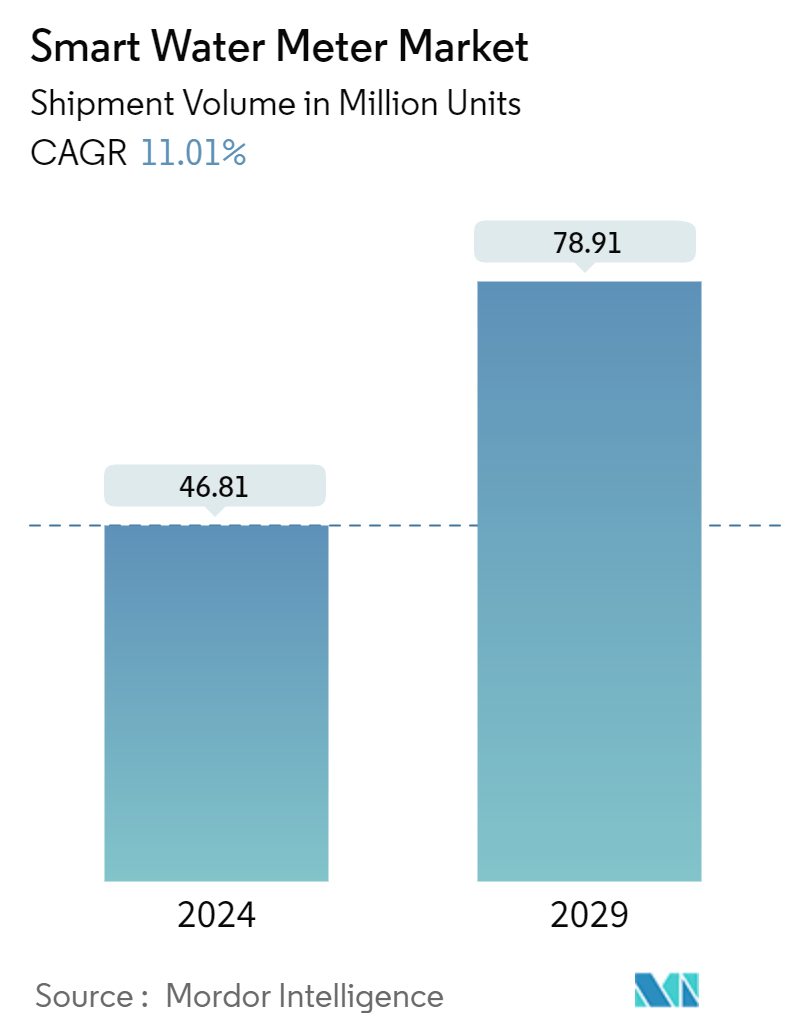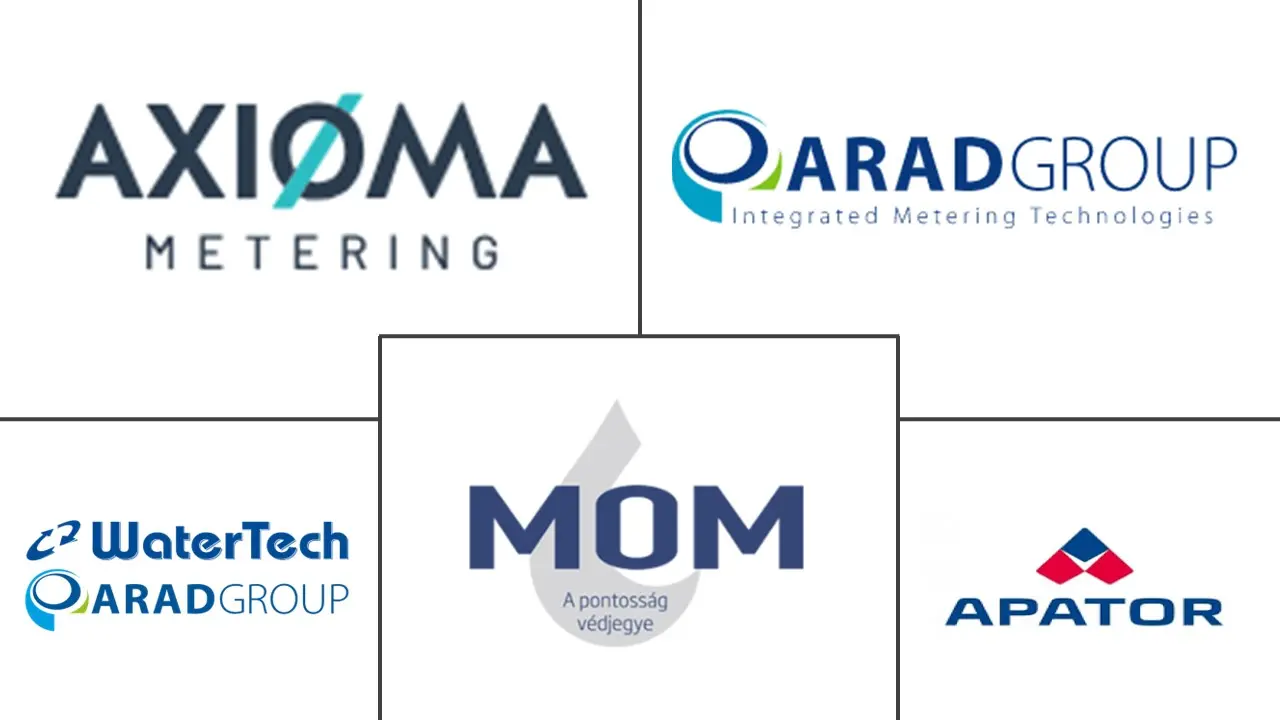Market Size of Smart Water Meter Industry

| Study Period | 2019 - 2029 |
| Market Volume (2024) | 46.81 Million units |
| Market Volume (2029) | 78.91 Million units |
| CAGR (2024 - 2029) | 11.01 % |
| Fastest Growing Market | Europe |
| Largest Market | Asia Pacific |
| Market Concentration | Low |
Major Players
*Disclaimer: Major Players sorted in no particular order |
Smart Water Meter Market Analysis
The Smart Water Meter Market size in terms of shipment volume is expected to grow from 46.81 Million units in 2024 to 78.91 Million units by 2029, at a CAGR of 11.01% during the forecast period (2024-2029).
Smart Water Meter Market: Driving Efficiency and Conservation
- Supportive Government Regulations Accelerate Adoption: Government initiatives and regulations are significantly advancing the smart water meter market. Utilities and municipalities are benefiting from substantial funding aimed at replacing traditional meters with smart alternatives. For instance, West Memphis received a USD 2.85 million grant to install over 9,000 smart meters, while San Jose Water secured approval for a USD 100 million investment in Advanced Metering Infrastructure (AMI). These efforts focus on enhancing customer service, reducing greenhouse gas emissions, and promoting water conservation.
- Government funding: Enables large-scale smart meter installations
- Regulatory support: Allows utilities to invest in AMI technology
- Environmental goals: Align with sustainability and conservation efforts
- Need for Improvement in Water Utility Usage and Efficiency: Water utilities are under increasing pressure to improve efficiency and address aging infrastructure. Smart water meters help utilities detect leaks, reduce water loss, and provide real-time usage data. For example, Dubai Electricity and Water Authority (DEWA) detected over 1.3 million leaks, leading to a reduction in CO2 emissions by 218,373 tons. In the U.S., where nearly 6 billion gallons of treated water are lost daily, investments in infrastructure are ramping up.
- Leak detection: Smart meters allow prompt identification and mitigation
- Real-time data: Supports improved water conservation strategies
- Infrastructure investment: Significant improvements are being planned
- Increasing Demand to Reduce Non-revenue Water Losses: Non-revenue water (NRW) losses represent a critical challenge for water utilities, both financially and environmentally. Smart meters help by providing accurate measurements, detecting leaks, and enabling data analysis. The Asian Development Bank highlights the importance of NRW reduction to improve service coverage and meet growing demand. For instance, Maynilad in Manila has reduced NRW to 30.31% while expanding service coverage to 95% using district metering and smart technology.
- NRW reduction: Smart meters help quantify and reduce water losses
- District metering: Improves water loss management efforts
- Utility success: NRW reduction through smart technology enhances operations
- Digitalization and Operational Efficiency: Smart water meters are driving the digital transformation of water utilities through AMI systems, which provide accurate, detailed information on water usage. This data improves decision-making, increases revenue, and enhances billing efficiency. Itron’s collaboration with Abbanoa SpA in Sardinia demonstrates how smart metering technology can help detect leaks and reduce NRW using ultrasound technology.
- AMI systems: Offer actionable insights for utilities
- Real-time monitoring: Enables rapid leak detection and issue resolution
- Digital transformation: Improves utility operations and customer service
- Market Landscape and Competitive Environment: The smart water meter market is highly competitive, featuring established players like Badger Meter, Honeywell, and Itron, along with emerging startups such as WaterGroup, which leverage IoT technologies. Increased partnerships between technology providers and utilities are accelerating the adoption of tailored solutions across regions.
- Established players: Drive innovation through comprehensive solutions
- Tech partnerships: Accelerate smart meter adoption globally
- Diverse offerings: Cater to a variety of utility needs
As water scarcity and efficient resource management grow in importance, the smart water meter market is poised for further expansion. The integration of advanced communication protocols and data analytics will enhance the role of smart water meters, solidifying their place in the future of water management.
Smart Water Meter Industry Segmentation
Smart water meters are devices used to measure the quantity/volume of water passing through a supply pipeline/outlet, which may include the primary water supply pipeline for an entire facility or a sub-zone. Measurements can be done in units, including cubic feet or gallons, among others.
The smart water metering market is segmented by technology (automatic meter reading, advanced metering infrastructure), by application (residential, commercial, industrial), and by geography (North America, Europe, Asia-Pacific, Latin America, Middle East, and Africa). The market sizes and forecasts are provided in terms of value (USD) for all the above segments.
| By Technology | |
| Automatic Meter Reading | |
| Advanced Metering Infrastructure |
| By Application | |
| Residential | |
| Commercial | |
| Industrial |
| By Geography*** | |
| North America | |
| Europe | |
| Asia | |
| Australia and New Zealand | |
| Latin America | |
| Middle East and Africa |
Smart Water Meter Market Size Summary
The smart water meter market is poised for significant growth, driven by the increasing need for efficient water management solutions amid rising water consumption due to urbanization and industrialization. These electronic devices offer numerous benefits, such as reducing meter reading costs, preventing disconnections, and eliminating billing inefficiencies. The demand for smart water meters is further fueled by technological advancements that allow for detailed monitoring of water usage, including flow rate and quality. Despite challenges like high costs and limited awareness, the market is expected to expand as governments and businesses prioritize water conservation and sustainability efforts. The COVID-19 pandemic has also heightened consumer awareness of digital technologies, potentially boosting market adoption in the long term.
In residential sectors, smart water meters are gaining traction as they provide accurate and timely measurements of water consumption, enabling consumers to manage their usage effectively and reduce bills. Government initiatives and regulations in various regions, particularly in Europe, are promoting the installation of smart water meters to address water scarcity issues. The market is characterized by fragmentation, with key players engaging in strategic partnerships and technological innovations to enhance their offerings. Recent developments include collaborations for advanced metering infrastructure and the integration of security technologies to protect user data. These efforts are expected to drive the market forward, offering opportunities for growth in both developed and developing regions.
Smart Water Meter Market Size - Table of Contents
-
1. MARKET INSIGHTS
-
1.1 Market Overview
-
1.2 Industry Attractiveness - Porter's Five Forces Analysis
-
1.2.1 Bargaining Power of Suppliers
-
1.2.2 Bargaining Power of Buyers/Consumers
-
1.2.3 Threat of New Entrants
-
1.2.4 Threat of Substitute Products
-
1.2.5 Degree of Competition
-
-
1.3 Industry Value Chain Analysis
-
1.4 Technology Snapshot for types of Smart Water Meter
-
1.5 ROI Analysis for Smart Meters
-
1.6 Prominent Protocols Used and their Comparison
-
1.7 Steps Involved in Implementing LoraWAN/Prominent Use-cases/Long-term Implications
-
1.8 Advantages/Digitalization Achieved by Utilities by Smart Meter Implementations
-
-
2. MARKET SEGMENTATION
-
2.1 By Technology
-
2.1.1 Automatic Meter Reading
-
2.1.2 Advanced Metering Infrastructure
-
-
2.2 By Application
-
2.2.1 Residential
-
2.2.2 Commercial
-
2.2.3 Industrial
-
-
2.3 By Geography***
-
2.3.1 North America
-
2.3.2 Europe
-
2.3.3 Asia
-
2.3.4 Australia and New Zealand
-
2.3.5 Latin America
-
2.3.6 Middle East and Africa
-
-
Smart Water Meter Market Size FAQs
How big is the Smart Water Meter Market?
The Smart Water Meter Market size is expected to reach 46.81 million units in 2024 and grow at a CAGR of 11.01% to reach 78.91 million units by 2029.
What is the current Smart Water Meter Market size?
In 2024, the Smart Water Meter Market size is expected to reach 46.81 million units.

